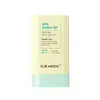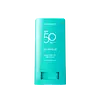What's inside
What's inside
 Key Ingredients
Key Ingredients

 Benefits
Benefits

 Concerns
Concerns

 Ingredients Side-by-side
Ingredients Side-by-side

Dimethicone
EmollientSilica
AbrasivePolyethylene
AbrasiveEthylhexyl Methoxycinnamate
UV AbsorberEthylhexyl Salicylate
UV AbsorberBis-Ethylhexyloxyphenol Methoxyphenyl Triazine
Skin ConditioningBenzyl Benzoate
AntimicrobialCaprylic/Capric Triglyceride
MaskingWater
Skin ConditioningPolyhydroxystearic Acid
EmulsifyingPolyglyceryl-4 Isostearate
EmulsifyingCoco-Caprylate/Caprate
EmollientCurcuma Longa Root Extract
MaskingPolyglyceryl-3 Polyricinoleate
EmulsifyingMelia Azadirachta Flower Extract
Skin ConditioningHippophae Rhamnoides Oil
EmollientSalvia Officinalis Oil
MaskingPrunus Amygdalus Dulcis Oil
Skin ConditioningSqualane
EmollientBisabolol
MaskingArgania Spinosa Kernel Oil
EmollientCocos Nucifera Oil
MaskingMelia Azadirachta Leaf Extract
Skin ConditioningHelianthus Annuus Seed Oil
EmollientMelia Azadirachta Bark Extract
AntimicrobialCorallina Officinalis Extract
Skin ConditioningMoringa Oleifera Seed Oil
EmollientOcimum Sanctum Leaf Extract
Skin ConditioningGlycerin
HumectantAdansonia Digitata Seed Oil
EmollientHydrogenated Lecithin
EmulsifyingDisteardimonium Hectorite
StabilisingAdenosine
Skin ConditioningSorbitan Isostearate
EmulsifyingSea Water
HumectantButylene Glycol
Humectant1,2-Hexanediol
Skin ConditioningTocopheryl Acetate
AntioxidantCamellia Sinensis Leaf Extract
AntimicrobialCentella Asiatica Extract
CleansingBifida Ferment Lysate
Skin ConditioningTocopherol
AntioxidantCeramide NP
Skin ConditioningGluconolactone
Skin ConditioningNiacinamide
SmoothingAllantoin
Skin ConditioningPanthenol
Skin ConditioningCeramide Ns
Skin ConditioningCeramide As
Skin ConditioningCeramide EOP
Skin ConditioningCeramide AP
Skin ConditioningCymbopogon Schoenanthus Extract
Skin ConditioningAloe Barbadensis Leaf Extract
EmollientPearl Extract
AntioxidantCollagen
MoisturisingCaprylyl Glycol
EmollientHyaluronic Acid
HumectantEthylhexylglycerin
Skin ConditioningPhellinus Linteus Extract
Skin ConditioningLinum Usitatissimum Seed Extract
PerfumingAcetyl Hexapeptide-8
HumectantBeta-Glucan
Skin ConditioningHydrolyzed Hyaluronic Acid
HumectantSodium Hyaluronate
HumectantOleic Acid
EmollientMethicone
EmollientGlyceryl Caprylate
EmollientParfum
MaskingDimethicone, Silica, Polyethylene, Ethylhexyl Methoxycinnamate, Ethylhexyl Salicylate, Bis-Ethylhexyloxyphenol Methoxyphenyl Triazine, Benzyl Benzoate, Caprylic/Capric Triglyceride, Water, Polyhydroxystearic Acid, Polyglyceryl-4 Isostearate, Coco-Caprylate/Caprate, Curcuma Longa Root Extract, Polyglyceryl-3 Polyricinoleate, Melia Azadirachta Flower Extract, Hippophae Rhamnoides Oil, Salvia Officinalis Oil, Prunus Amygdalus Dulcis Oil, Squalane, Bisabolol, Argania Spinosa Kernel Oil, Cocos Nucifera Oil, Melia Azadirachta Leaf Extract, Helianthus Annuus Seed Oil, Melia Azadirachta Bark Extract, Corallina Officinalis Extract, Moringa Oleifera Seed Oil, Ocimum Sanctum Leaf Extract, Glycerin, Adansonia Digitata Seed Oil, Hydrogenated Lecithin, Disteardimonium Hectorite, Adenosine, Sorbitan Isostearate, Sea Water, Butylene Glycol, 1,2-Hexanediol, Tocopheryl Acetate, Camellia Sinensis Leaf Extract, Centella Asiatica Extract, Bifida Ferment Lysate, Tocopherol, Ceramide NP, Gluconolactone, Niacinamide, Allantoin, Panthenol, Ceramide Ns, Ceramide As, Ceramide EOP, Ceramide AP, Cymbopogon Schoenanthus Extract, Aloe Barbadensis Leaf Extract, Pearl Extract, Collagen, Caprylyl Glycol, Hyaluronic Acid, Ethylhexylglycerin, Phellinus Linteus Extract, Linum Usitatissimum Seed Extract, Acetyl Hexapeptide-8, Beta-Glucan, Hydrolyzed Hyaluronic Acid, Sodium Hyaluronate, Oleic Acid, Methicone, Glyceryl Caprylate, Parfum
C12-15 Alkyl Benzoate
AntimicrobialOctocrylene
UV AbsorberHomosalate
Skin ConditioningSilica
AbrasiveBis-Ethylhexyloxyphenol Methoxyphenyl Triazine
Skin ConditioningPolyethylene
AbrasiveTribehenin
EmollientDimethicone/Vinyl Dimethicone Crosspolymer
Skin ConditioningIsohexadecane
EmollientEthylhexyl PCA
HumectantMea-Salicylate
PreservativeButyl Methoxydibenzoylmethane
UV AbsorberButyloctyl Salicylate
Skin ConditioningDimethicone
EmollientPolymethyl Methacrylate
Phenoxyethanol
PreservativeTocopheryl Acetate
AntioxidantEthylhexylglycerin
Skin ConditioningTocopherol
AntioxidantParfum
MaskingC12-15 Alkyl Benzoate, Octocrylene, Homosalate, Silica, Bis-Ethylhexyloxyphenol Methoxyphenyl Triazine, Polyethylene, Tribehenin, Dimethicone/Vinyl Dimethicone Crosspolymer, Isohexadecane, Ethylhexyl PCA, Mea-Salicylate, Butyl Methoxydibenzoylmethane, Butyloctyl Salicylate, Dimethicone, Polymethyl Methacrylate, Phenoxyethanol, Tocopheryl Acetate, Ethylhexylglycerin, Tocopherol, Parfum
 Reviews
Reviews

Ingredients Explained
These ingredients are found in both products.
Ingredients higher up in an ingredient list are typically present in a larger amount.
You might know this ingredient as Tinosorb S or Bemotrizinol. It is a UV filter that covers both UVA and UVB rays.
This ingredient has two peak UV absorption peaks ( 310 and 340 nm) and is able to absorb both UV-A and UV-B rays. This ingredient works by preventing UV rays from reaching and damaging your skin.
On top of that - it is highly photostable and helps prevent the photodegration of other sunscreen ingredients such as avobenzone.
Tinosorb S is allowed in the EU, Australia, and Asia. It is close to being approved by the FDA and we'll hopefully get this ingredient in the U.S. by late 2025.
Fun fact: Tinosorb S is the most effective UV absorber at maximum concentration (measured by SPF) permitted in the EU.
This ingredient is oil-soluble, so your oil-cleansers will take this right off at night.
Learn more about Bis-Ethylhexyloxyphenol Methoxyphenyl TriazineDimethicone is a type of synthetic silicone created from natural materials such as quartz.
What it does:
Dimethicone comes in different viscosities:
Depending on the viscosity, dimethicone has different properties.
Ingredients lists don't always show which type is used, so we recommend reaching out to the brand if you have questions about the viscosity.
This ingredient is unlikely to cause irritation because it does not get absorbed into skin. However, people with silicone allergies should be careful about using this ingredient.
Note: Dimethicone may contribute to pilling. This is because it is not oil or water soluble, so pilling may occur when layered with products. When mixed with heavy oils in a formula, the outcome is also quite greasy.
Learn more about DimethiconeEthylhexylglycerin (we can't pronounce this either) is commonly used as a preservative and skin softener. It is derived from glyceryl.
You might see Ethylhexylglycerin often paired with other preservatives such as phenoxyethanol. Ethylhexylglycerin has been found to increase the effectiveness of these other preservatives.
Parfum is a catch-all term for an ingredient or more that is used to give a scent to products.
Also called "fragrance", this ingredient can be a blend of hundreds of chemicals or plant oils. This means every product with "fragrance" or "parfum" in the ingredients list is a different mixture.
For instance, Habanolide is a proprietary trade name for a specific aroma chemical. When used as a fragrance ingredient in cosmetics, most aroma chemicals fall under the broad labeling category of “FRAGRANCE” or “PARFUM” according to EU and US regulations.
The term 'parfum' or 'fragrance' is not regulated in many countries. In many cases, it is up to the brand to define this term.
For instance, many brands choose to label themselves as "fragrance-free" because they are not using synthetic fragrances. However, their products may still contain ingredients such as essential oils that are considered a fragrance by INCI standards.
One example is Calendula flower extract. Calendula is an essential oil that still imparts a scent or 'fragrance'.
Depending on the blend, the ingredients in the mixture can cause allergies and sensitivities on the skin. Some ingredients that are known EU allergens include linalool and citronellol.
Parfum can also be used to mask or cover an unpleasant scent.
The bottom line is: not all fragrances/parfum/ingredients are created equally. If you are worried about fragrances, we recommend taking a closer look at an ingredient. And of course, we always recommend speaking with a professional.
Learn more about ParfumPolyethylene is a synthetic ingredient that helps the skin retain moisture. It is a polymer.
It is also typically used within product formulations to help bind solid ingredients together and thicken oil-based ingredients. When added to balms and emulsions, it helps increase the melting point temperature.
Silica, also known as silicon dioxide, is a naturally occurring mineral. It is used as a fine, spherical, and porous powder in cosmetics.
Though it has exfoliant properties, the function of silica varies depending on the product.
The unique structure of silica enhances the spreadability and adds smoothness, making it a great texture enhancer.
It is also used as an active carrier, emulsifier, and mattifier due to its ability to absorb excess oil.
In some products, tiny microneedles called spicules are made from silica or hydrolyzed sponge. When you rub them in, they lightly polish away dead skin layers and enhance the penetration of active ingredients.
Learn more about SilicaTocopherol (also known as Vitamin E) is a common antioxidant used to help protect the skin from free-radicals and strengthen the skin barrier. It's also fat soluble - this means our skin is great at absorbing it.
Vitamin E also helps keep your natural skin lipids healthy. Your lipid skin barrier naturally consists of lipids, ceramides, and fatty acids. Vitamin E offers extra protection for your skin’s lipid barrier, keeping your skin healthy and nourished.
Another benefit is a bit of UV protection. Vitamin E helps reduce the damage caused by UVB rays. (It should not replace your sunscreen). Combining it with Vitamin C can decrease sunburned cells and hyperpigmentation after UV exposure.
You might have noticed Vitamin E + C often paired together. This is because it is great at stabilizing Vitamin C. Using the two together helps increase the effectiveness of both ingredients.
There are often claims that Vitamin E can reduce/prevent scarring, but these claims haven't been confirmed by scientific research.
Learn more about TocopherolTocopheryl Acetate is AKA Vitamin E. It is an antioxidant and protects your skin from free radicals. Free radicals damage the skin by breaking down collagen.
One study found using Tocopheryl Acetate with Vitamin C decreased the number of sunburned cells.
Tocopheryl Acetate is commonly found in both skincare and dietary supplements.
Learn more about Tocopheryl Acetate